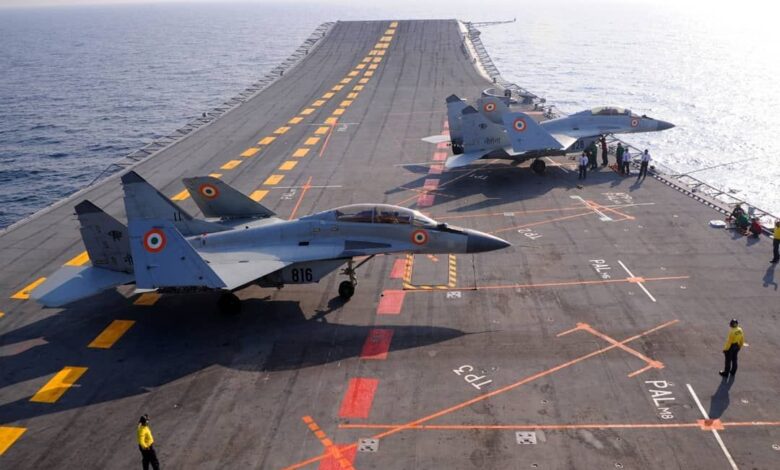The main fighters of INS Vikrant, India’s biggest ship ever built, would be “Black Panthers,” a naval version of the MiG-29 made in Russia.
The plane has been used by the Indian Air Force for a long time.
Up to 35 planes can fit on the aircraft carrier. The MiG-29K will be flown from the INS Vikrant and will be used to attack both the air and the ground.
The MiG-29K is a fighter plane that can fly in any weather and can go faster than twice the speed of sound, or Mach 2. It can pull with up to eight times the force of gravity and fly to more than 65,000 feet in the air.
The MiG-29K can attack targets in the air, on the water, and on land, and it can fly long distances to complete important missions because it can refuel in the air.
INAS 303 is the name of the MiG-29K squadron, which is also called the “Black Panthers.” It marked the beginning of a new era of fighter flying in the Indian Navy, so it was called a “game-changer.” The INS Hansa in Goa is where the squadron is based.
The MiG-29K is powerful enough to do both “air dominance” and “power projection” at the same time. This gives the fleet commander at sea a lot of options.
The warship’s airwing will also have Kamov-31 helicopters, MH-60R multi-role helicopters from the US, and Advanced Light Helicopters (ALH) and Light Combat Aircraft from Russia (LCA).
The MiG-29K (Korabelny) is an aeroplane from the 4.5th generation. It is very different from the versions of the IAF MiG-29B that are best for air-to-air missions.
In two shipments, Russia sent 45 MiG-29K/KUB fighters to India. In 2016, the second group of 29 planes was sent out. In 2011, the first group of 16 planes was sent out.
In 2020, the Defense Ministry agreed to buy 21 MiG-29s and upgrade 59 MiG-29s at a cost of Rs 7,418 crore, which is about $1 billion.
It is a fighter that can switch between air-to-air and air-to-ground operations. In the meantime, India is also working to improve this plane’s capabilities. The Navy is testing a new mission computer for the Mikoyan-Gurevich MiG-29K/KUB fighter planes that fly from aircraft carriers.
The mission computer was made by Hindustan Aeronautics Ltd, which is a state-owned company. The new system is meant to give the Navy the option to combine air-launched weapons made in the country or in the West with the Soviet-era MiG-29K.
A source in the business world who knew about the project said that the programme started in January 2021, when Russia refused to update the mission computer or give HAL the source code.
It could take another five to six months for the INS Vikrant to be ready for battle. Until then, fighter planes will fly missions and surface-to-air Barack missiles will be installed on the warship. The tests should start in November and end in May of 2023.
Steel Authority of India Limited (SAIL) worked with the Defense Research and Development Laboratory (DRDL) and the Navy to make warship-grade steel for the first time in the country. This steel was used to make 26,000 tonnes of the INS Vikrant.
All of the country’s warships are now made from the steel made for warships.
Four General Electric LM2500 engines power the INS Vikrant. This gives it a top speed of 28 knots and a range of 7500 nautical miles. The ship has more than 2200 rooms for its crew of about 1600 people. There are also special rooms for female officers and sailors.
When INS Vikrant is put into service, the Navy will be able to run two aircraft carriers at the same time. The other one is INS Vikramaditya. This would solve the problem that the Navy has with keeping operations going while the other ship is being fixed.
MiG-29K fighter jets will be on India’s new aircraft carrier. But the Indian Navy is already looking for naval fighters that can do more than one thing for INS Vikrant.
The MiG-29Ks that are currently used by the INS Vikramaditya will be replaced by a twin-engine plane that the Indian Navy wants to buy.
The F/A-18E/F Super Hornet from Boeing and the Rafale-M from Dassault, which is the naval version of the French multi-role fighter, are competing to sell warplanes that can fly from a carrier to the Indian Navy.
The Navy has already put both fighters through flight tests at the INS Hansa shore-based test facility in Goa. These tests were done to see which plane would work best with the 40,000-ton INS Vikrant.
The STOBAR (Short Take-Off But Arrested Recovery) technology is used to launch fighter planes. The INS Vikrant has a ski-jump and three “arrester wires” to bring the plane back to the ship after it has been launched.
It hasn’t been decided yet which fighters will replace the MiG-29K, but many aviation experts have favoured the Dassault Rafale because the Indian Air Force has been very happy with its performance, and the Rafale-M has been called the perfect aircraft for the Navy.
